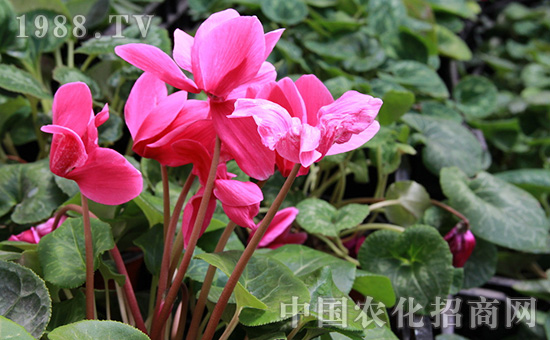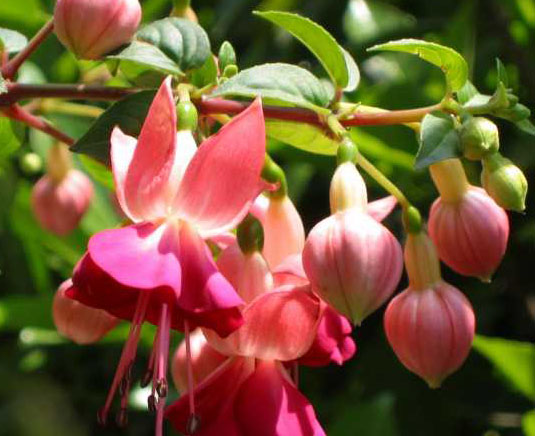How to control cyclamen diseases and insect pests
(1) root knot nematode disease. The nematode invades the root of the seedling and grows many nodules large and small on the main root and lateral root. The nematode sucks the juice in the tumor, causing the fine root to be swollen and rot, and the aboveground part withered.
Prevention and control methods:
① disinfects the soil before planting, stir-fry the soil in an iron pan for 40 minutes, take it out when the soil becomes dry and white, and then use it after cooling.
After the onset of ②, the rhizosphere soil of cyclamen was irrigated with 1000 times of dichlorvos.
(2) bacterial soft rot. After the disease, the leaves, petioles and flower stems near the root, will occur water-like softening, and spread downward, resulting in tuber soft rot. The disease is serious in the high temperature and rainy season from July to August.
Prevention and control methods:
① disinfects the soil with 1% formalin solution before planting.
In the early stage of ②, the diseased leaves were cut off immediately, and 200 μ g / g agricultural streptomycin solution was sprayed on the affected area.

Root knot nematode disease
The main results are as follows: 1. the granules such as gram-line phosphorus, dichloroisopropyl ether, C-line phosphorus (Yishuobao), benzene line phosphorus (Li Manku) and Mianlong (must be killed quickly) were selected for soil treatment.
2. Put the infected seed ball into 50 ℃ water and soak 10min to kill nematodes.
Grey mold disease
1. Use fungicides during planting, such as thiram and dimethazone, to disinfect the soil or replace it with new soil, so as to prevent the spread of diseases by soil.
2. Strengthen indoor ventilation and reduce humidity appropriately; watering should not be too much, and it is not suitable to directly water the leaf surface, so as to avoid causing wounds in maintenance and management to prevent bacteria from invading.
3. Remove diseased plants and diseased leaves in time to reduce the source of bacteria.
4. Spray protective fungicides before onset, such as: 600-800 times of Lvdebao, 75% chlorothalonil 800 times of chlorothalonil; spray therapeutic fungicides when onset of the disease, such as 70% methyl thiophanate 800 times, 50% carbendazim 500-800 times, and so on.
Viral disease
1. Inhibit seed poisoning: 75% alcohol treatment for 1 min, then 15min treated with 10% trisodium phosphate, rinse the seed surface with distilled water, cool naturally in 35 ℃ warm water for 24 hours, and sow in sterilized soil. Seed detoxification: when the seeds were put in 40% polyethylene glycol solution and treated at 38.5 ℃ for 48 h, the seed detoxification rate could reach 77.7%.
2. Tissue culture seedlings with corms, leaf tips and petioles as explants to reduce the virus-carrying rate.
3. The planting soil should be disinfected or disinfected vermiculite, perlite, sand and so on.
Root rot disease
For the seedling disease, root water stains, softening rot, diseased seedlings wilted and withered and died.
Prevention and control measures:
1. Soak the seeds in 0.1% copper sulfate solution for half an hour for disinfection.
2. Before sowing, spray 1800 potassium permanganate solution to disinfect the soil.
3. Strengthen ventilation, control humidity, properly release air and cultivate seedlings to enhance resistance.
4. In the early stage of cripple disease, 72.2% Pulicol water agent, 50% Likujing and 40% Gen Funing 1000 times solution can be sprayed or irrigated.
Bacterial soft rot
The leaves produce waterlogged disease spots, and then soft rot, overflow of white bacteria, plant wilting and death.
Prevention and control measures:
1. Remove diseased leaves and diseased plants.
2. Control watering and pay attention to ventilation.
3. Spray control with 1000-2000 times liquid of 50% carbendazim wettable powder.
Anthrax
Damage leaves and pedicels. Brown round spots appeared at the initial stage, black dots appeared in the later stage, and red sticky mass overflowed when wet.
Prevention and control measures:
1. Cut off the diseased leaves in time.
2. Strengthen ventilation and light transmission and reduce humidity.
3. 60% anthrax Fumei and 70% methyl topiramate wettable powder 800 times solution can be used for prevention and treatment.
Ground fly
The larvae do harm to young stems and roots, and when serious, the seedlings die.
Control measures: 2.5% deltamethrin EC 3000 times solution can be used to control it, and the effect of spraying on the ground around the plant is better.
Mites
Harm to bulbs, leaves, flowers, so that buds rot, leaves green distortion distortion.
Prevention and control measures:
1. Remove weeds and reduce insect population.
2. Spray 73% carbamate EC 2000 times. When the insect population density is high, spray 2-4 times continuously, each time at an interval of 10 days.
Thrips
Harm to young leaves and flowers, spots, markings, buds, new leaves, flowers withered, leaves twisted and yellow.
Prevention and control measures:
1. Hang the blue armyworm board.
2. Spray 1000 times of phoxim EC or 2000-2500 times of imidacloprid wettable powder.
Aphids
It harms young leaves and buds, forms galls, induces coal fouling disease and spreads virus.
Prevention and control measures:
1. Prevention and control of natural enemies such as ladybugs and lacewings.
2. Set up armyworm board to trap or cover with plastic film to avoid aphids.
3. Alternate spray control with 2000 times solution of 50% aphid fog wettable powder and 10% imidacloprid 1500 times solution.
Tide worm
Gnawing on leaves, roots, and stems, causing leaves and stems to etch and fester.
Prevention and control measures:
1. Remove weeds and sprinkle with quicklime powder.
2. Spray the ground and grass curtain with 50% carbaryl wettable powder or 2.5% deltamethrin 2000 times to induce insect poisoning.
Slug
Scrape the leaves until the plant dies.
Prevention and control measures:
1. Apply mature organic fertilizer.
2. High border cultivation, covering plastic film, breaking plastic film and raising seedlings to reduce the harm.
3. Camellia oleifera withered powder and water were soaked in the proportion of 1:10 for 24 hours, and the filtered water was diluted 20-50 times to drench the seedling bed or spray.
4. Sprinkle raw lime powder around the killed plants.
5. In the evening, 2% poison bait for killing dry snails was spread on the ridges.
Shell worm
Harm leaves and flowers.
Prevention and control measures:
1. Get rid of the infected plants in time.
2. Spray 10% imidacloprid EC 1000 times or 25% Fen Jieling 1500 times for prevention and control.
Extended reading:
Cyclamen culture methods, fertilization techniques, pest control, flowers and legends
Prevention and control of diseases and insect pests of cyclamen
① Botrytis cinerea. Occurs on leaves, petioles and flowers of cyclamen.
Prevention and treatment: during the onset of the disease, 1000-1500 times of topiramate or 1% equal amount of Wulbordo solution can be used and sprayed once every half month.
② charcoal blast. Most of them occur on the back of cyclamen leaves, which are brown spots at the beginning, and the disease spots extend outward in the shape of a wheel, nearly round or irregular, and black-gray grains will appear on the disease spots in the later stage.
Prevention and treatment methods: after the infected leaves of the disease are found, the diseased leaves should be cut off and destroyed in time, or 50% carbendazim wettable powder can be sprayed once a week, usually 2-3 times can be effective.
③ bacterial soft rot. It often occurs on the petiole and bulb of cyclamen, showing water stain softening in the initial stage, white or dark gray-green disease spot, soft rot, expansion and rupture of the diseased tissue, exfoliation of epidermis and bad smell.
Prevention and treatment methods: strengthen ventilation, pay attention to drainage and shelter from rain, or spray and smear diseased plants with streptomycin or oxytetracycline or penicillin solution, or irrigate the rhizosphere soil of diseased plants with 700 times solution of diexamethasone.
④ root knot nematode disease. Root-knot nematode parasites on the root of cyclamen. The stimulation of nematode secretion can make the root tissue hypertrophy and proliferation, form many nodules, thus destroy the normal function of the root, lead to growth weakening, and even death. The original solution can be used to fumigate and disinfect the soil and wait for 2 weeks before sowing or transplanting. 15-50 grams of 3% furan granules can also be buried in the basin for prevention and treatment.
⑤ cyst nematode. After the cyst nematode invades the root of the seedling, it forms many insects of different sizes. In severe cases, the fine roots turn brown and rot, and the leaves die orange. The method of controlling root-knot nematode can be used.
- Prev

Botrytis cinerea
Symptoms and pathological changes: Botrytis cinerea is called leaf mold. The main damage to leaves was from late April to early May, and the peak period was in the early and middle of August. From July to August, there is much rainfall and high humidity, which is beneficial to the spread of diseases. The disease is more serious in the courtyard where the planting is too dense and the cultivation management is poor. After suffering from frost injury
- Next

How to prevent and cure tulip virus disease
Virus disease is the main reason for the degradation of tulip germplasm. There are many kinds of viruses that harm tulips, including mosaic virus and broken color virus. The leaves of plants infected by mosaic virus appear yellow stripes or fine-grained spots, which produce dark spots on the petals and rot in severe cases.
Related
- Fuxing push coffee new agricultural production and marketing class: lack of small-scale processing plants
- Jujube rice field leisure farm deep ploughing Yilan for five years to create a space for organic food and play
- Nongyu Farm-A trial of organic papaya for brave women with advanced technology
- Four points for attention in the prevention and control of diseases and insect pests of edible fungi
- How to add nutrient solution to Edible Fungi
- Is there any good way to control edible fungus mites?
- Open Inoculation Technology of Edible Fungi
- Is there any clever way to use fertilizer for edible fungus in winter?
- What agents are used to kill the pathogens of edible fungi in the mushroom shed?
- Rapid drying of Edible Fungi

